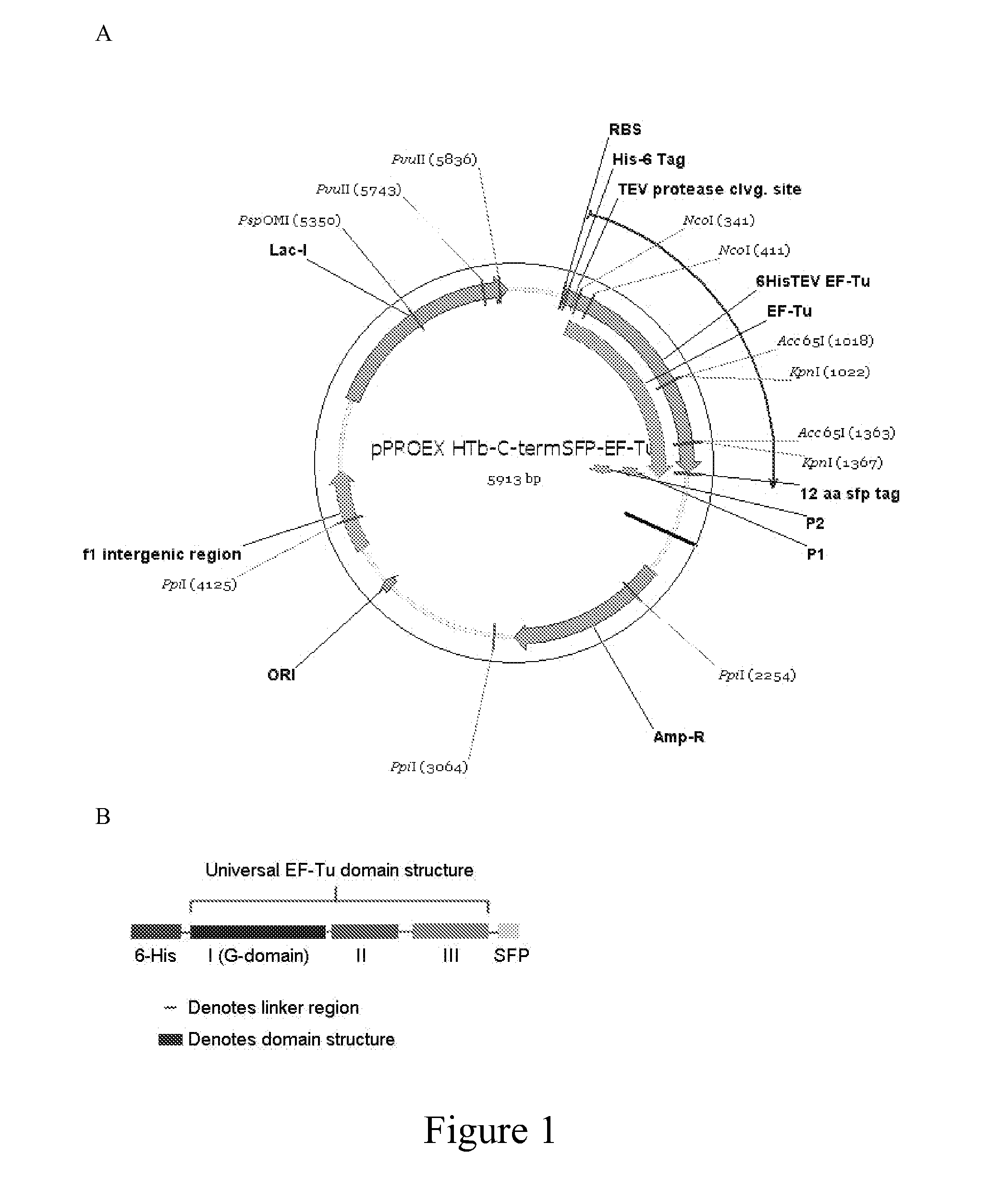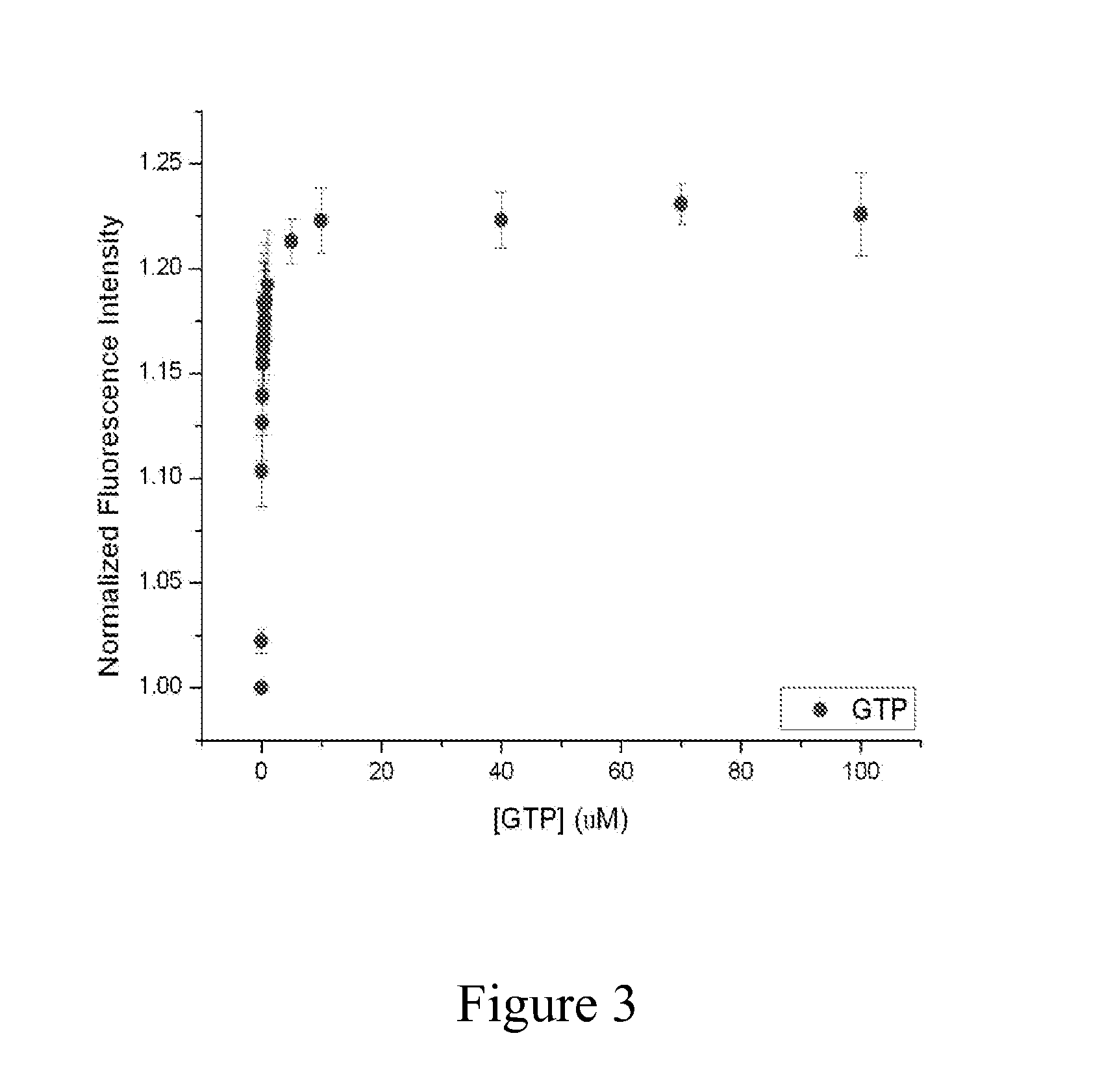Signal amplification methods for the imaging of protein synthesis and neurotransmitter transport
- Summary
- Abstract
- Description
- Claims
- Application Information
AI Technical Summary
Benefits of technology
Problems solved by technology
Method used
Image
Examples
example 1
Preparation of Quencher-Bound EF-Tu, Various Components and General Methods
A. Preparation of Active, Quencher-Bound EF-Tu
[0076]EF-Tu from E. coli was PCR amplified and cloned into the bacterial expression vector pPROEX-Ht-b through restriction enzyme technologies. This clone includes an N-terminal 6-histidine (6-His) tag separated from the native protein sequence by a TEV protease cleavage site so that both tags can be proteolytically removed from the protein at the appropriate step following purification and fluorescent labeling. Into this clone of EF-Tu, originally described in Blanchard 2004a and Blanchard 2004b, an SFP epitope or sequence tag composed of 12 amino acids on the C-terminus was introduced to produce pPROEX HTb-C-termSFP-EF-Tu (FIG. 1). Fluorescence quenchers are enzymatically coupled to the SFP tag according to the method of Yin 2006.
B. Preparation of tRNA and Ribosomes
[0077]Fluorophore-labeled tRNA from E. coli was prepared by site-specifically attaching the donor ...
example 2
Bulk Ternary Complex Analysis
[0080]Initial experiments focused on the molecular determinants of ternary complex formation in vitro using E. coli EF-Tu and tRNAPhe. As shown in FIG. 2, a fluorescence based approach was initially developed, whereby the tRNAPhe molecule was fluorescently labeled at position 47 (acp3U47) with a donor (Cy3) fluorophore, which exhibits a change in quantum yield upon ternary complex formation. Depending on the solution conditions of the experiment, the formation of ternary complex can be detected as either a rise or fall in fluorescence intensity depending strongly on the solution conditions of the Cy3 fluorophore linked to tRNAPhe. Other tRNA species (e.g., Cy3-labeled tRNALys) undergo similar changes in fluorescence intensity. These data showed that under the conditions of the experiment, ternary complex formation was strictly dependent on the presence of an aminoacyl moiety at the 3′-terminus of tRNAPhe (resulting from its “charging” by phenylalanyl tRN...
example 3
FRET Efficiency in Ternary Complex Formation
[0082]To better determine the FRET efficiency between the Cy3 and Cy5 fluorophores within the ternary complex, and the potential efficiency of Cy3 “quenching,” single-molecule experiments were performed where Cy3-labeled EF-Tu was surface immobilized within passivated, microfluidic reaction chambers via its N-terminal 6-His tag following previously published procedures (Zhao 2010). For these experiments the 6-His tag was not proteolytically removed after purification and labeling. Cy5-labeled Phe-tRNAPhe was then stopped-flow injected into the chamber and ternary complex formation was followed by the appearance of FRET (FIG. 5). The FRET value observed in the complex can be readily obtained from the raw data as the charged coupled device employed during imaging shows nearly identical sensitivities to both Cy3 and Cy5 fluorescence. The FRET efficiency of the interaction, determined by the ratio of Cy5 intensity over total intensity, is appr...
PUM
| Property | Measurement | Unit |
|---|---|---|
| Fraction | aaaaa | aaaaa |
| Fluorescence | aaaaa | aaaaa |
Abstract
Description
Claims
Application Information
 Login to View More
Login to View More - R&D
- Intellectual Property
- Life Sciences
- Materials
- Tech Scout
- Unparalleled Data Quality
- Higher Quality Content
- 60% Fewer Hallucinations
Browse by: Latest US Patents, China's latest patents, Technical Efficacy Thesaurus, Application Domain, Technology Topic, Popular Technical Reports.
© 2025 PatSnap. All rights reserved.Legal|Privacy policy|Modern Slavery Act Transparency Statement|Sitemap|About US| Contact US: help@patsnap.com



